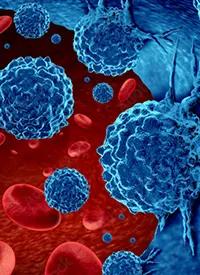News
Article
NX-1607 Is Under Phase 1 Evaluation in DLBCL and Other Advanced Malignancies
Author(s):
The phase 1a/1b NX-1607-101 trial will evaluate NX-1607, a CBL-B inhibitor, in patients with advanced malignancies, including diffuse large B-cell lymphoma.
NX-1607 in DLBCL | Image Credit:
© freshidea - stock.adobe.com

The phase 1a/1b NX-1607-101 trial (NCT05107674) will evaluate NX-1607, a CBL-B inhibitor, in patients with advanced malignancies, including diffuse large B-cell lymphoma (DLBCL), according to a poster that was presented during the 2023 ASH Annual Meeting. The dose-escalation portion of the trial is ongoing at 14 locations across the United States and United Kingdom.1
NX-1607 is designed to enhance innate and adaptive immune responses and demonstrate antitumor activity and long-term survival in patients with persistent lymphoma.
“NX-1607 has demonstrated antitumor activity and long-term survival in murine models as a single agent and in combination with PD-1 antibodies. NX-1607 may, as a single agent, enhance the efficacy of endogenous T-cell- and NK-cell-mediated anti-tumor activity, thus supplementing, and rescuing [chimeric antigen receptor] CAR-T or [natural killer] NK cell therapies in patients with hematologic malignancies that have developed resistance,” investigators wrote in the poster.1,2
In this first-in-human, multicenter, open-label, dose-escalation/expansion trial, investigators will evaluate safety, tolerability, pharmacokinetics (PK) and pharmacodynamics (PD) and preliminary anti-tumor activity with the use of NX-1607 treatment in up to 303 patients. Patients are treated until disease progression or unacceptable toxicity. Phase 1a will focus on dose-escalation with an accelerated, 3+3 dose-escalation design and, if applicable, phase 1b will focus on dose-expansion.
The primary objectives for phase 1a are safety, tolerability, maximum tolerated dose (MTD), and/or recommended phase 1b dose (RP1bD), and the primary objectives for phase 1b will be safety, tolerability, preliminary antitumor activity measured using RECIST v1.1, modified RECIST, and the PK and PD of NX-1607. Primary end points for phase 1a include treatment related adverse events including grade 3 or greater, serious adverse events, immune related adverse events, deaths, and dose-limiting toxicity. The primary end point for phase 1b is objective response rate. Exploratory end points in both phases is a CBL-B signaling pathway analysis, which includes changes in blood and tumor tissue biomarkers and circulating blood tumor-specific biomarkers.
In phase 1a of the trial, up to 109 patients will be assigned to either of 2 arms. Patients in arm 1 are given increasing doses of NX-1607 monotherapy, starting from 5 to 100 mg every day for a duration of 21 days, and in arm 2 patients are given NX-1607 dose escalation plus paclitaxel until MTD or RP1bD. In phase 1b of the trial, focusing on dose expansion for patients with advanced malignancies, up to 194 patients will be assigned into either of the same dosing groups as phase 1a but will potentially include multiple cohorts.
Patients eligible for the trial must be 18 year or older, have measurable metastatic or unresectable malignancies that were non-responsive to standard therapy, or the available therapy was no longer a suitable option for the patient, and an ECOG performance status of 0 or 1. In phase 1b accessible tumor or lymph node for biopsy is needed for patients with DLBCL. Exclusions include, untreated active brain metastases, prior treatment with checkpoint inhibitors within 3 weeks, prior radiation within 2 weeks, prior CART-cell therapy within 30 days, and prior stem cell transplant within 100 days. Other exclusions include, a history of uveitis, inability to swallow capsules, and major therapy planned within 4 weeks of treatment initiation. Patients who received prior treatment, including checkpoint inhibitors or CAR T-cell therapy are eligible with a protocol defined washout period.
Patient cohorts and inclusion criteria include the following cancer types, however, further inclusions are listed within these subsets: head and neck squamous cell carcinoma, malignant pleural mesothelioma, triple-negative breast cancer, melanoma, gastric or gastroesophageal junction adenocarcinoma, microsatellite stable colorectal cancer, urothelial cancer, epithelial ovarian cancer, non–small cell lung cancer, cervical cancer, metastatic castrate-resistant prostate cancer, and DLBCL/DLBCL-Richter transformation.
Regarding biomarker analyses of CBL-B signaling pathway and target engagement, the following may be included in the trial evaluation: immune cell infiltration in the tumor, immune profiles in circulation after exposure to NX-1607, characterization of systemic immune characteristics, and gene expression and mutational landscape.1
NX-1607 is an oral treatment designed as a small molecule inhibitor of CBL-B gene. It enhances antigen recall, reduces T cell exhaustion, and increases cytokine production upon T cell receptor stimulation, overcoming suppressive signals from the tumor microenvironment.
DLBCL remains a challenging disease to treat despite advances like cell-based and immune-mediated therapies. This is because T cell dysfunction and the emerging resistance observed in therapies that activate T cells, like CAR T-cell therapy and T cell engagers rely on stimulating T cells to attack cancer cells. CBL-B is an E3 ubiquitin ligase found in immune cells acting as a major controller of T cells, natural killer cells, and dendritic cell activation, limiting their ability to fight against tumors. However, when CBL-B is absent, it has been observed that T cells can still become activated even when the tumor cells have low levels of antigens. This observation shows a potential strategy for overcoming the tumor’s resistance mechanisms, leading to the NX-1607 treatment design.
Investigators in the poster noted that dose escalation is ongoing.
References
- Collins GP, Townsend W, Abdulgawad A, et al. A first-in-human phase 1 trial of NX-1607, a first-in-class oral CBL-B inhibitor, in patients with advanced malignancies including DLBCL. Blood. 2023;142(suppl 1):3093-3093. doi:10.1182/blood-2023-172875
- Nurix Therapeutics. Inhibitors of the E3 ubiquitin ligase CBL-B promote potent T and NK cell mediated anti-tumor response. 17th annual drug discovery Chemistry, April 19, 2022. San Diego, CA, USA. Accessed December 11, 2023. https://www.nurixtx.com/wp-content/uploads/2022/05/NX1607-Discovery-chemistry-talk-4-18-2022.pdf






%20(2)%201-Recovered-Recovered-Recovered-Recovered-Recovered.jpg?fit=crop&auto=format)

%20(2)%201-Recovered-Recovered-Recovered-Recovered-Recovered.jpg?fit=crop&auto=format)
%20(2)%201-Recovered-Recovered-Recovered-Recovered-Recovered.jpg?fit=crop&auto=format)